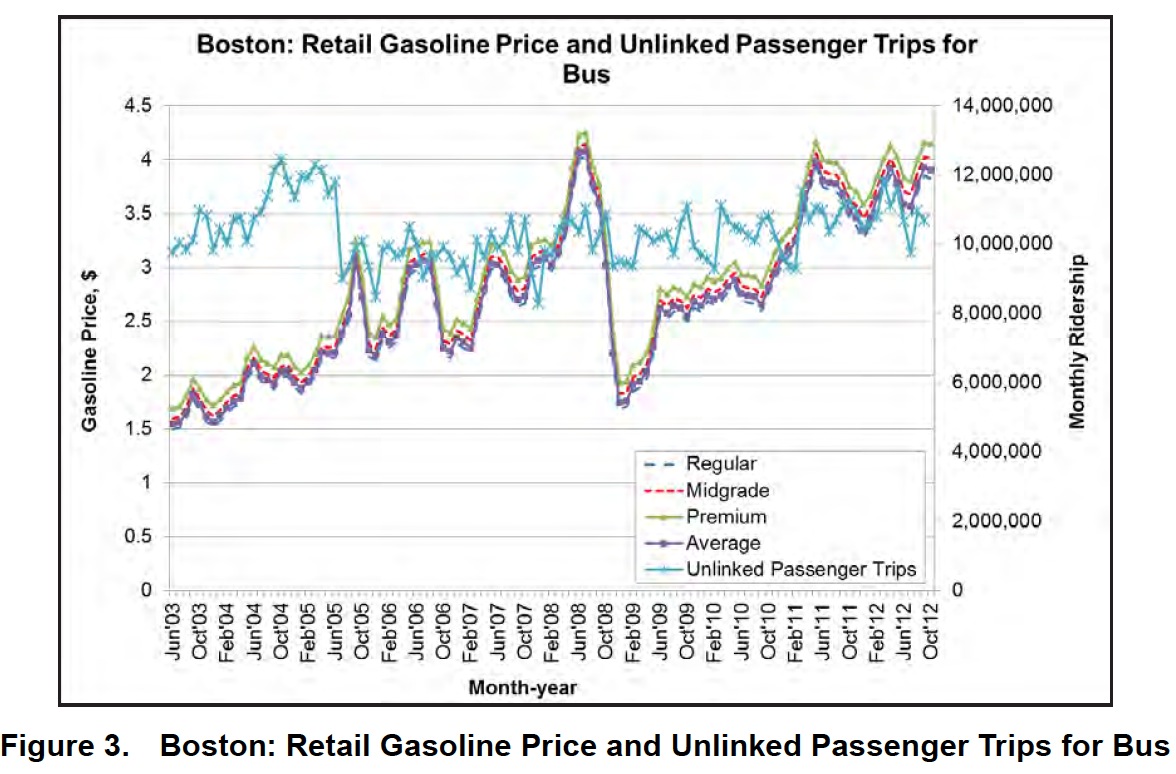MINETA TRANSPORTATION INSTITUTE
EXECUTIVE SUMMARY
Between 1999 and 2011 consumers in the U.S. experienced an unprecedented increase in and fluctuation of gasoline prices. In July 2008, gasoline prices exceeded $4 per gallon, marking the highest price in real value in U.S. history. In the same year, the nation’s transit ridership reached 10.7 billion trips, the highest level since the Federal- Aid Highway Act of 1956.
The rising gasoline prices were considered to have resulted in substantial changes in travel behavior in terms of trip taking, choices of travel destinations, selection of vehicles for higher fuel efficiency, or travel mode. A change in travel mode from driving to transit results in a higher level of transit demand and ridership for transit agencies. With this background, gasoline price increases in the last decade have generated substantial interest in developing a better understanding of how people respond to fluctuations in gasoline prices—particularly with respect to switching modes from driving to public transit—so that transit agencies can better prepare for higher demand for their services during periods of increased gasoline prices.
The extensive literature review conducted for this study revealed that estimated values of elasticity obtained in the previous studies varied by geographic area, transit mode, travelers’ demographic characteristics, trip characteristics, types of data, and analytical method. In particular, types of ridership data used in the previous studies included cross-sectional, time-series, pooled, and panel datasets of ridership for one or multiple agencies. The literature review revealed several important data and methodological issues that should be addressed in an analysis in addition to several different types of effects of gasoline prices on transit ridership.
Based on the literature review, the study has made improvements in developing four specifications of panel data regression analysis to analyze the net effect of gasoline prices on ridership in ten major urbanized areas (UAs) in the U.S. over a ten-year period. First, this study used monthly data on gasoline prices and ridership in order to gauge the effects in the short and long term. Monthly gasoline price data were collected from the Energy Information Administration, Department of Energy, for ten major UAs over the period of 2002 to 2011; monthly transit ridership data by agency were obtained from the National Transit Database and processed to obtain data for the ten UAs. Transit ridership data included the four main modes of transit—bus, commuter rail, light rail and heavy rail—and the aggregate of these four modes. The use of panel data allowed us to simultaneously take into account temporal and cross-sectional variation to obtain more robust, generalizable results.
To minimize the effects of omitted variables, a regression analysis was used to comprehensively control for a set of variables that potentially affect transit ridership, including factors both internal and external to transit services, such as, in the former case, transit fare and service frequency, and, in the latter, economic conditions and socioeconomic characteristics of potential travelers. In addition to the baseline specification model that simply examines potentially influential factors of transit ridership, the instrumental variable (IV) method was employed to address simultaneity between the supply of service and ridership (IV model), which may cause a bias in estimated coefficients of other independent variables, including gasoline prices. Comparison of the results from these first two models confirmed that there is no substantial difference in the estimated coefficients for gasoline prices. Thus, the two models that examine short- and long-term effects and non-constant elasticity were specified based on the baseline specification.
About Mineta Transportation Institute
transweb.sjsu.edu
“The Mineta Transportation Institute (MTI) conducts research, education, and information and technology transfer, focusing on multimodal surface transportation policy and management issues. It was established by Congress in 1991 as part of the Intermodal Surface Transportation Efficiency Act (ISTEA) and was reauthorized under TEA-21 and again under SAFETEA-LU. The Institute is funded by Congress through the US Department of Transportation’s (DOT) Research and Innovative Technology Administration, by the California Legislature through the Department of Transportation (Caltrans), and by other public and private grants and donations, including grants from the US Department of Homeland Security.”
Tags: Boston, MA, Massachusetts, Mineta Transportation Institute, San Jose State University







 RSS Feed
RSS Feed